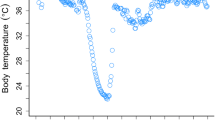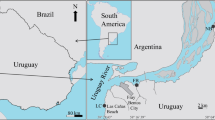Abstract
Living on islands entails numerous challenges for animals, among which resource scarcity stands out. In order to survive, animals have to optimize energy acquisition. We examined the impact of insularity on digestion comparing a series of physiological and morphological traits of adult males between insular and mainland populations of the Balkan green lizard. Island lizards had longer gastrointestinal tracts and gut passage times and higher digestive efficiencies. The dissection of the hindgut revealed an unexpected finding, the presence of cecal valves that were more frequent in island lizards. Thanks to all above islanders retain food for longer periods and thus maximize energy income and increase the amount of the extracted nutrients. That way, they secure energy income from the limited, in time and quantity, food resources of the islands.



Similar content being viewed by others
References
Adler GH, Levins R (1994) The island syndrome in rodent populations. Q Rev Biol 69:473–490
Alexis MN, Papaparaskeva-Papoutsoglou E, Theochari V (1985) Formulation of practical diets for rainbow trout (Salmo gairdneri) made by partial or complete substitution of fish meal by poultry by-products and certain plant by-products. Aquaculture 50:61–73
Barton NWH, Houston DC (1993) A comparison of digestive efficiency in birds of prey. Ibis 135(4):363–371
Beaupre SJ, Dunham AE, Overall KL (1993) The effects of consumption rate and temperature on apparent digestibility coefficient, urate production, metabolizable energy coefficient and passage time in canyon lizards (Sceleporus merriami) from two populations. Funct Ecol 7:273–280
Bennett AF, Dawson WR (1976) Metabolism. In: Gans C, Dawson WR (eds) Biology of the Reptilia. Academic, London and New York, pp 127–223
Bjorndal K (1997) Fermentation in reptiles and amphibians. In: Mackie R, White B (eds) Gastrointestinal microbiology. (Chapman & Hall Microbiology Series) Chapman & Hall, New York, pp 199–230
Brown RP, Pérez-Mellado V (1994) Ecological energetics and food acquisition in dense menorcan islet population of the lizard Podarcis lilfordi. Funct Ecol 8(4):427–434
Carretero MA (1997) Digestive size and diet in Lacertidae: a preliminary analysis. In: Böhme W, Bischoff W, Zeigler T (eds) Herpetologia Bonnensis. S.E.H, Bonn, pp 43–49
Carretero MA (2004) From set menu to à la carte. Linking issues in trophic ecology of Mediterranean lacertids. Ital J Zool 2:121–133
Clegg SM, Owens IPF (2002) The ‘island rule’ in birds: medium body size and its ecological explanation. Proc R Soc Lond B 269(1498):1359–1365
Cooper WE, Pyron RA, Garland T (2014) Island tameness: living on islands reduces flight initiation distance. Proc R Soc Lond B 281(1777):20133019
da Silva JM, Herrel A, Measey GJ, Vanhooydonck B, Tolley KA (2014) Linking microhabitat structure, morphology and locomotor performance traits in a recent radiation of dwarf chameleons. Funct Ecol 28(3):702–713
Dearing MD (1993) An alimentary specialization for herbivory in the tropical whiptail lizard Cnemidophorus murinus. J Herpetol 27(1):111–114
Dubois M, Gilles KA, Hamilton JK, Rebers BA, Smith F (1956) Colorimetric method for determination of sugars and related substances. Anal Chem 28:350–356
Fuentes JA (1984) Evolution of lizard niches in Mediterranean habitats. In: Di Castri F, Goodall DW, Specht R (eds) Mediterranean type shrublands: ecosystems of the world, vol 11. Elsevier Science Publishing Co, Amsterdam, pp 417–444
Herrel A (2007) Herbivory and foraging mode in lizards. In: Reilly SM, McBrayer LD, Miles DB (eds) Lizard ecology: the evolutionary consequences of foraging mode. Cambridge University Press, Cambridge, pp 209–236
Herrel A, Huyghe K, Vanhooydonck B, Backeljau T, Breugelmans K, Grbac I, Van Damme R, Irschick DJ (2008) Rapid large-scale evolutionary divergence in morphology and performance associated with exploitation of a different dietary resource. Proc Natl Acad Sci 105(12):4792–4795
Herrel A, Vanhooydonck B, Van Damme R (2004) Omnivory in lacertid lizards: adaptive evolution or constraint? J Evol Biol 17(5):974–984
Iverson JB (1982) Adaptations to herbivory in iguanine lizards. In: Burghardt GM, Rand AS (eds) Iguanas of the world: their behavior, ecology and conservation. Noyes, Park Ridge, pp 60–76
Karasov WH, Martinez Del Rio C (2007) Physiological ecology: how animals process energy, nutrients, and toxins. Princeton University Press, New Jersey
Layne E (1957) Spectrophotometric and turbidimetric methods for measuring proteins. Methods Enzymol 10:447–455
Li B, Belasen A, Pafilis P, Bednekoff P, Foufopoulos J (2014) Effects of feral cats on the evolution of anti-predator behaviours in island reptiles: insights from an ancient introduction. Proc R Soc Lond B 281(1788)
Lopez-Darias M, Vanhooydonck B, Cornette R, Herrel A (2015) Sex-specific differences in ecomorphological relationships in lizards of the genus Gallotia. Funct Ecol 29(4):506–514
Losos JB, Ricklefs RE (2009) Adaptation and diversification on islands. Nature 457(7231):830–836
McConnachie S, Alexander GJ (2004) The effect of temperature on digestive and assimilation efficiency, gut passage time and appetite in an ambush foraging lizard, Cordylus melanotus melanotus. J Comp Physiol B 174(2):99–105
McKinon W, Alexander GJ (1999) Is temperature independence of digestive efficiency an experimental artefact in lizards? A test using the common flat lizard (Platysuarus intermedius). Copeia 1999:299–303
McNab BK (1994) Energy conservation and the evolution of flightlessness in birds. Am Nat 144(4):628–642
Monti DM, Raia P, Vroonen J, Maselli V, Van Damme R, Fulgione D (2013) Physiological change in an insular lizard population confirms the reversed island syndrome. Biol J Linn Soc 108(1):144–150
Naya DE, Veloso C, Sabat P, Božinović F (2011) Physiological flexibility and climate change: the case of digestive function regulation in lizards. Comp Biochem Physiol A Mol Integr Physiol 159(1):100–104
Pafilis P, Foufopoulos J, Poulakakis N, Lymberakis P, Valakos E (2007) Digestive performance in five Mediterranean lizard species: effects of temperature and insularity. J Comp Physiol B 177(1):49–60
Pérez-Mellado V, Corti C (1993) Dietary adaptations and herbivory in lacertid lizards of the genus Podarcis from western Mediterranean islands (Reptilia: Sauria). Bonn Zool Bull 44(3/4):193–220
Raia P, Guarino F, Turano M, Polese G, Rippa D, Carotenuto F, Monti D, Cardi M, Fulgione D (2010) The blue lizard spandrel and the island syndrome. BMC Evol Biol 10(1):289
Raia P, Meiri S (2006) The island rule in large mammals: paleontology meets ecology. Evolution 60(8):1731–1742
Sagonas K, Pafilis P, Lymberakis P, Donihue CM, Herrel A, Valakos ED (2014) Insularity affects head morphology, bite force and diet in a Mediterranean lizard. Biol J Linn Soc 112:469–484
Sagonas K, Pafilis P, Lymberakis P, Valakos ED (2015) Trends and patterns in the feeding ecology of the widespread Balkan lizard Lacerta trilineata (Squamata: Lacertidae) in insular and continental Greece. North-West J Zool 11(1):117–126
Sagonas K, Valakos ED, Pafilis P (2013) The impact of insularity on the thermoregulation of a Mediterranean lizard. J Therm Biol 38(8):480–486
Schluter D (1984) Body size, prey size and herbivory in the Galápagos lava lizard Tropidurus. Oikos 43:291–300
Skoczylas R (1978) Physiology of the digestive tract. In: Gans C, Tinkle DW (eds) Biology of the Reptilia. Academic, London, pp 589–717
Sokol OM (1967) Herbivory in lizards. Evolution 21:192–194
Starck JM, Beese K (2002) Structural flexibility of the small intestine and liver of garter snakes in response to feeding and fasting. J Exp Biol 205(10):1377–1388
Valakos ED, Pafilis P, Sotiropoulos K, Lymberakis P, Maragou P, Foufopoulos J (2008) The amphibians and reptiles of Greece. Chimaira, Frankfurt am Main
Van Damme R (1999) Evolution of herbivory in lacertid lizards: effects of insularity and body size. J Herpetol 33:663–674
Van Damme R, Bauwens D, Verheyen RF (1991) The thermal dependence of feeding behaviour, food consumption and gut-passage time in the lizard Lacerta vivipara Jacquin. Funct Ecol 5(4):507–517
van Marken Lichtenbelt WD (1992) Digestion in an ectothermic herbivore, the green Iguana (Iguana iguana): effect of food composition and body temperature. Physiol Zool 65(3):649–673
Vervust B, Pafilis P, Valakos ED, Van Damme R (2010) Anatomical and physiological changes associated with a recent dietary shift in the lizard Podarcis sicula. Physiol Biochem Zool 83(4):632–642
Zimmerman LC, Tracy RC (1989) Interactions between the environment and ectothermy and herbivory in reptiles. Physiol Zool 62(2):374–409
Author information
Authors and Affiliations
Corresponding author
Additional information
Communicated by: Sven Thatje
Rights and permissions
About this article
Cite this article
Sagonas, K., Pafilis, P. & Valakos, E.D. Effects of insularity on digestion: living on islands induces shifts in physiological and morphological traits in island reptiles. Sci Nat 102, 55 (2015). https://doi.org/10.1007/s00114-015-1301-8
Received:
Revised:
Accepted:
Published:
DOI: https://doi.org/10.1007/s00114-015-1301-8




